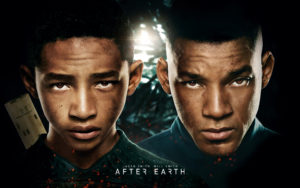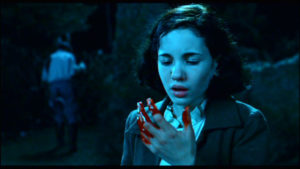How the coming of age and rite of passage fantasy film of twenty-first-century cinema has refreshed the depiction of sexual identity and gender roles.
The box office figures tell us that everybody loves a coming of age film. If it has elements of science fiction and/or fantasy as well, then success is almost guaranteed. From the surreal setting of the The Wizard of Oz (Fleming, 1939) and the fairy tale world of Disney’s Beauty and the Beast (Trousdale & Wise 1991, Condon 2017), to the futuristic planet-scape of After Earth (Shyamalan, 2013), a weird parallel reality always seems to be a good testing ground for the child who is in the process of making the painful transition to adulthood. This essay examines the way gender roles are presented in two relatively recent fantasy/science fiction films: After Earth and Pan’s Labyrinth (Del Toro, 2006) The first film focuses on a young boy’s mission with his military father to save the world from destruction by aliens. The second film depicts a young girl’s epic journey through a war-torn earth and a mysterious underworld, likewise with a mission to save her world, albeit from all too human aggressors. The themes of war and human suffering provide a backdrop to the narrative of growing into adulthood in both films, but there are interesting dimensions to the way gender is handled in each.
The popularity of science fiction and fantasy films is mainly a matter of audience demographics since the largest group of cinema visitors is young people aged 12-24 years (Kochberg, 2012). These films are important, because they are carriers of contemporary cultural values and aspirations, reflecting, and perhaps also in some cases challenging, the norms of everyday social action. Films of this type which feature adolescent protagonists are clearly popular, but are there any signs that they are reflecting or projecting greater diversity in gender role representations? Or do they just reproduce the familiar, somewhat stereotypical representations of the past in terms of gender?
One way of looking at this is to consider just how complex film taxonomy is becoming, these days. When a new film appears, it is often difficult to attribute it to any one style or genre. The textbooks tell us that “genre is an effect of repetition” (Villarejo, 2013), and that films use certain codes to orient the viewer towards a whole range of other works that have presented similar stories in the past. The genre of science fiction, for example, favours scenes which alternate between CGI space scenes with usually a ship navigating through a strange universe, interspersed with some action within the tight confines of a space ship or station, and occasional encounters with alien and usually dangerous beings. Technology, alien creatures and tensions between different world views, philosophies and ways of living are perhaps three of the most recognisable themes of the science fiction genre and are prevalent in that that most recognisable of franchises Star Trek.
The father figure in After Earth (Shyamalan, 2013), played by Hollywood superstar Will Smith, is a classic masculine hero of science fiction genre: a senior military figure with an illustrious past as a space pilot and commander. He portrays the hyper-masculine behaviours of all military organisations, requiring wordless obedience from his son, setting high standards for his school work and behaviour. The boy’s mother, on the other hand, exhibits stereotypically feminine, nurturing behaviours and is, of course, visually attractive and clad in glamorous evening wear.
 Figure 1: Poster for After Earth (Shyamalan, 2013)
Figure 1: Poster for After Earth (Shyamalan, 2013)
In this film, the costumes show father and son in matching jumpsuits, and the facial features of both actors are strikingly similar, which is not surprising either since they are in real life a Smith family father/son combo. Patriarchy is clearly having a field day in this film, as much in the real-world financial and administrative level as on the level of the film’s plot. The boy’s struggle to escape from his father’s oppressive tutelage and find his own identity is achieved through multiple adventures with wild indigenous species. There is not much questioning of the macho traditions of the military in this film, nor is there much character progression in either father or son. Junior follows in his father’s footsteps and will no doubt continue this rather rigid and uninspiring method of bringing up his own offspring.
This film shows that the adult male action hero stands supreme in American cinema, and is not looking to give up his dominance lightly. Since the ground-breaking character of Ripley (Sigourney Weaver) first stalked the horrific extra-terrestrial enemy in Alien (Scott, 1979) a few women have taken a more active role in science fiction films. The role of the adolescent in Hollywood’s science fiction and fantasy appears to be stuck in the gender-segregated world of the mid-twentieth century, in fact, it can be argued that even Ripley is just a female equivalent of the clichéd male action hero.
Outside of the Hollywood mainstream, however, the story is not so familiar. The transition from childhood to adulthood is portrayed in fantasy classic Pan’s Labyrinth (Del Toro, 2006) against the background of the Spanish Civil War. The film recalls also a much older tradition going back to the allegorical myths of Ancient Greece and Rome, and the moral tales of witches, monsters and talking animals. The film shares some of the same codes as science fiction, such as a fascination with improbable, non-human creatures and exploration of unfamiliar social and political settings. It has a decidedly magical element too, and a strong moral message about the defence of family and territory against any kind of injustice, and against the evils of war in particular.
The supernatural dimension here is provided by the gloomy underworld, into which the young protagonist Ofelia descends. Father figures are menacing, and mostly absent, whereas the mother figure is in many ways deficient, as Ofelia is left to tackle the problem of human suffering on her own. There is obvious mirroring between the world above and below ground, and a focus on the agency that children have, since in this story it is a young girl who decides her own and her brother’s destiny.
It is possible to read this film from a feminist perspective, as an exploration of hybridity. Ofelia is both above and below, both protagonist and victim, arguably taking on masculine as well as feminine roles as she faces up to the problem of evil in the world. Ofelia, must make a decision to sacrifice her baby brother, or suffer herself, and this subverts contemporary Western societies’ tendency to depict children as passive creatures who are guarded by adults, but not allowed to participate in any important matters. The sacrifice of innocence, in this film, is not through the glorification of a baby, as in the Christian tradition, but through the bravery of a girl acting out her own moral judgements.

Figure 2: Screenshot from Pan’s Labyrinth (2006 Del Toro)
In this very influential film, it is within the adolescent girl’s power to counter the masculine forces of fascism and war, through the sacrificial shedding of her blood. Gender roles truly have been reversed in this film, and this is evidence of a move away from the stereotyping of the past. It has been noted that this director’s films “provoke the audience to question wider political and social questions” (Etherington-Wright and Doughty, 2011). The question of gender is not the main focus of the film, but it is interesting to observe how the ending of the film emphasises the tragedy of female sacrifice. The male voiceover at the end narrates the kind and just reign of Ofelia in the underground, which is no doubt intended to contrast sharply with the oppressive reality of the real world. The message seems to be, that if women ruled the world, then everybody would live happier and more peaceful lives.
It seems, then, that different branches of contemporary cinema are sending different messages in their coming of age films when it comes to gender roles. The post-modern technological future of Hollywood, and of the classic science fiction genre, appears to peddle the classic masculinity as seen in the western of the 60’s and 70’s. Men must teach their sons to go out and subdue the indigenous beings that threaten to stop their all-conquering advance through unexplored worlds.
A new, more magical and much more questioning folkloric perspective is offered by Del Toro’s film. This genre looks inwards and backwards, as well as forwards, seeking to learn from the mistakes of the past, and engage young women in the search for new ways of social interaction that are more effective than the bloody wars of the twentieth century. Strong, calm, self-sacrificing women, even in the years before full adulthood, may hold the secret to saving the world we all live in right now. This new folklore could well inspire a new generation of girls and boys to reject the guns and machines of modern and post-modern civilisations and return instead to the moral mysteries of the past. The path leads down, and back, into ourselves, rather than up and on, into the distant stars. It is only by understanding our own dreams, learning from our society’s dreadful failings, and listening to the timeless lessons of mythology that we can build a safer future for all.
Bibliography.
Condon (2017) Beauty and the Beast [Film] United States: Disney
Del Toro (2006) Pan’s Labyrinth. [Film] Spain/Mexico: Warner Bros.
Etherington-Wright, C. and Doughty, R. (2011) Understanding Film Theory. Basingstoke: Palgrave Macmillan.
Fleming, V. (1939) The Wizard of Oz. [Film] United States: Loew’s Inc.
Kochberg, S. (2012) The industrial contexts of film production. In J. Nelmes (Ed.), Introduction to Film Studies. Fifth edition. Abingdon: Oxford, pp. 2-40..
Watson, P. (2012) Approaches to film genre – taxonomy/genericity/metaphor. In J. Nelmes (Ed.), Introduction to Film Studies. Fifth edition. Abingdon: Oxford, pp. 188-208.
Scott, R. (1979) Alien. [Film]. UK/US: 29th Century Fox.
Shyamalan, M. N. (2013) After Earth. [Film]. United States: Columbia Pictures.
Trousdale & Wise (1991) Beauty and the Beast [Film] United States: Disney
Villarejo, A. (2013) Film Studies: The Basics. Second edition. Abingdon: Routledge.
